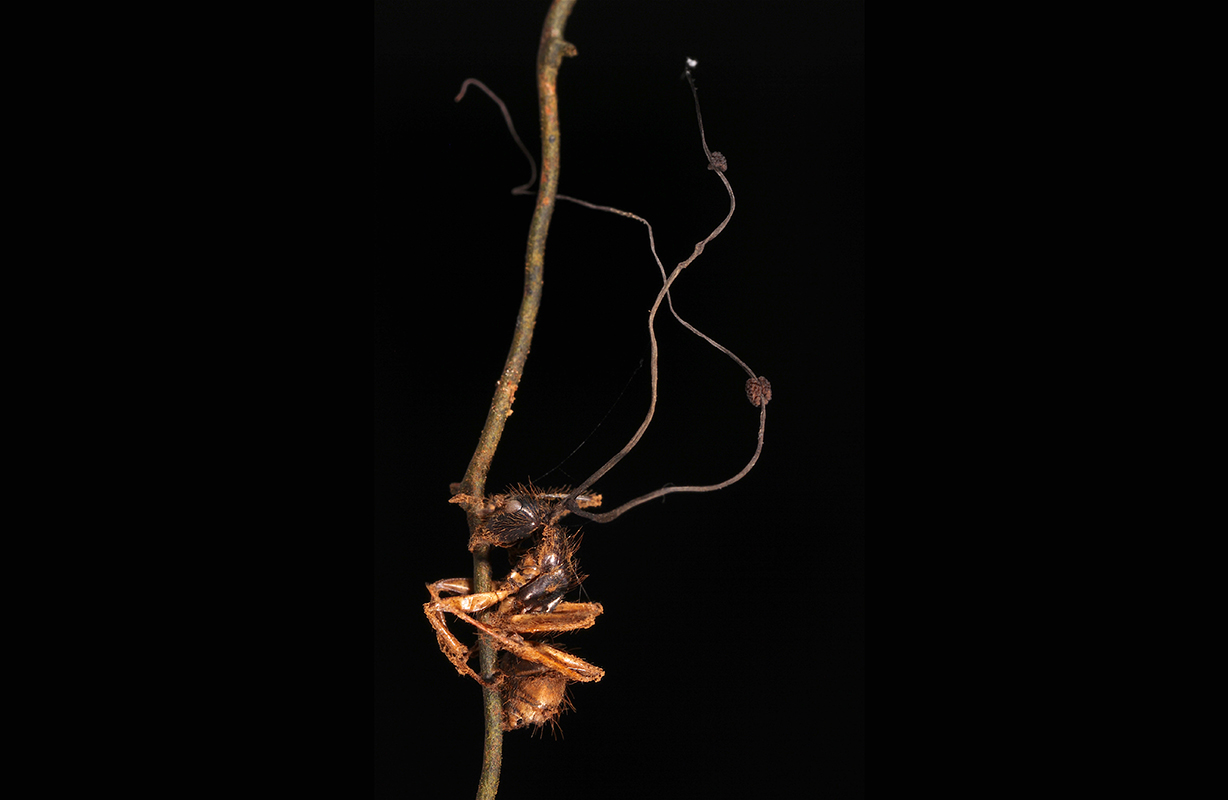Zombies in Sci-Fi Novel Have Gruesome Real-World Inspiration
A new science-fiction novel by author M. R. Carey features a team of biologists racing against time to find a cure for a zombie "plague" caused by a parasitic fungus, which is overwhelming human populations at an alarming pace.
But unlike most of the zombie-creating infectious agents that populate sci-fi stories, this one is grounded in horrific reality.
The hapless human zombies in "The Boy on the Bridge" (Orbit Books, 2017) are mindless automatons with only one objective on their minds — consuming human flesh and transmitting the zombie infection, caused by a parasitic fungus identified in the novel as "cordyceps." It was inspired by a real — and deadly — fungus genus known as Ophiocordyceps, which not only parasitizes ants but also hijacks their neural networks. These ant "zombies" behave in ways that are atypical for ants, but which help the fungus reproduce — in the end, the fungus bursts from the ant's body, killing its host. [Mind Control: Gallery of Zombie Ants]
The novel's fictional fungus parasitizes people almost instantaneously, controlling them absolutely within moments of exposure through a zombie's bite. In a world already overrun by zombie cannibals, biologists under armed escort venture from the relative safety of a military base on a mission to collect data on the zombies, or "hungries," to find a weakness in the fungus that could help them develop a vaccine or a cure.
Among the biologists is a brilliant teenage boy, Stephen Greaves, who makes an astounding discovery about an unexpected symbiosis that evolved between the fungus and some of its human hosts — all of whom are children. That knowledge comes with a terrible price, driving him toward a decision that could threaten the lives of his colleagues, and endanger humanity's survival.
When Carey first considered the idea of a zombie plague, he quickly identified a promising candidate in an ant-parasitizing fungus featured in the 1995 BBC One documentary, "The Private Life of Plants," he told Live Science.
"The footage of the fruited body [of the fungus] emerging from the ant's head — it's absolutely horrific, spellbinding stuff," he said.
Sign up for the Live Science daily newsletter now
Get the world’s most fascinating discoveries delivered straight to your inbox.

"The fungus doesn't affect any warm-blooded species — the idea that it could jump across so many biological barriers in one single bound is kind of ridiculous — but there's a hint in the book that there was some genetic manipulation going on," Carey said.
"If you accept that premise, it works really well. It neuro-hijacks an organism, shuts down higher brain functions, and turns human beings into feral animalistic machines with a single drive," he said.
40 million years of ant zombies
Real-world ants infected with Ophiocordyceps are eventually compelled to climb and attach themselves to plants in locations that are optimal for the fungus to release its spores. And the relationship between certain ant species and the fungus group Ophiocordyceps unilateralis — a complex of many species — is very old, dating to approximately 40 million years ago, João Araújo, a doctoral candidate studying the so-called zombie-ant fungus in the biology graduate program at Penn State University, told Live Science in an email.
Fungi in the Ophiocordyceps genus hold many fascinating questions for biologists. It is not yet known how the fungus chemically manipulates ant behavior, and researchers are still investigating the specific mechanisms of how the fungus takes over its host's body, Araújo said. [Zombie Facts: Real and Imagined (Infographic)]
However, scientists suspect that once spores penetrate an ant's exoskeleton, they immediately start to multiply and suppress the ant's immune system. Fungal outgrowths can be seen peeping from the ant's leg joints and from sutures in its exoskeleton within a single day, soon followed by the fruiting body of the fungus on a long stalk, Araújo said.

Once the ant is dead, the fungus continues to inhabit the corpse until its spores are ready to be released. How long that takes depends on the fungus species and where it lives — in the Amazon, that cycle can take a month or less, but in temperate regions that same cycle can take more than a year, according to Araújo.
And like the unfortunate human hosts in Carey's novel, ants infected with the zombie fungus face a grim prognosis. Could they ever recover from zombification?
"Not that we know," Araújo told Live Science.
No happy ending
"The Boy on the Bridge" revisits a world that Carey first introduced in the short story that became the novel, "The Girl with All the Gifts" (Orbit Books, 2014), later adapted as a film by the same name that was released in 2017. The new story takes place in the decade before the first book, offering a glimpse of the circumstances that set the stage for humanity's last stand against fungus-controlled, cannibalistic zombies, Carey said.
The title character, Greaves, "functions as a bridge between humans and the hungries," Carey explained. "He stands a little way off from human society — partly because he's on the autism spectrum, and relationships present to him differently than they do to many people, and partly from the effects of trauma, from horrific bereavement at a very early stage in his life."
Without giving away too much, "The Boy on the Bridge" doesn't wrap up with humanity neatly eradicating the fungus and returning to the way things were, pre-zombies. Survival in nature, after all, frequently hinges on successful adaptation, which can mean that species take an unexpected evolutionary detour. That may sound bleak, but Carey still sees the story's ending as hopeful, he told Live Science.
"This comes from a position of almost near-despair when I look at the state of the world today — what we're doing to the environment, what we're doing to ourselves," Carey said.
"This world-spanning civilization that we've built over the last four to five thousand years is about used up. It either has to die or mutate into something else — it has to change into something different," he added.
"The Boy on the Bridge" is available to buy on Amazon.
Original article on Live Science.

Mindy Weisberger is an editor at Scholastic and a former Live Science channel editor and senior writer. She has reported on general science, covering climate change, paleontology, biology and space. Mindy studied film at Columbia University; prior to Live Science she produced, wrote and directed media for the American Museum of Natural History in New York City. Her videos about dinosaurs, astrophysics, biodiversity and evolution appear in museums and science centers worldwide, earning awards such as the CINE Golden Eagle and the Communicator Award of Excellence. Her writing has also appeared in Scientific American, The Washington Post and How It Works Magazine. Her book "Rise of the Zombie Bugs: The Surprising Science of Parasitic Mind Control" will be published in spring 2025 by Johns Hopkins University Press.









